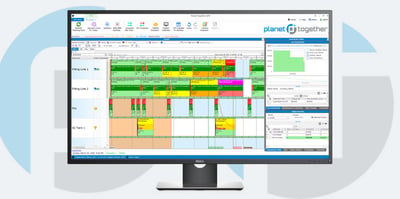Collaborative Robotics Applications in Assembly Lines and Warehouse Operations
The pursuit of efficiency is relentless in landscape of industrial manufacturing. Production schedulers play a crucial role in orchestrating the complex dance of machinery, materials, and manpower to optimize output while minimizing costs. In recent years, the integration of collaborative robotics has emerged as a game-changer, revolutionizing assembly lines and warehouse operations.
In this blog, we'll look into the transformative potential of collaborative robotics and explore how their integration with advanced planning and enterprise resource planning (ERP) systems like PlanetTogether, SAP, Oracle, Microsoft, Kinaxis, Aveva, and others can supercharge efficiency in industrial manufacturing facilities.

The Rise of Collaborative Robotics
Traditional industrial robots have long been a staple of assembly lines, performing repetitive tasks with speed and precision. However, their large size, high cost, and limited flexibility have constrained their applicability in certain settings, particularly those requiring close human interaction. Collaborative robots, or cobots, have emerged as a solution to these limitations. Designed to work alongside human workers, cobots offer a range of benefits, including:
Safety: Equipped with advanced sensors and intelligent algorithms, cobots can detect the presence of humans and adjust their behavior accordingly, minimizing the risk of accidents.
Flexibility: Unlike their traditional counterparts, cobots are lightweight, portable, and easily reprogrammable, allowing for rapid reconfiguration to accommodate changing production needs.
Cost-Effectiveness: With lower upfront costs and quicker deployment times, cobots offer an attractive alternative to traditional automation solutions, especially for small and medium-sized enterprises (SMEs).
Collaboration: By working in tandem with human operators, cobots enable closer collaboration and enhanced productivity, leveraging the unique strengths of both humans and machines.

Applications in Assembly Lines
In assembly line operations, cobots are being deployed across a wide range of tasks, from pick-and-place operations to quality inspection and packaging. Their ability to work alongside human workers in tight spaces makes them particularly well-suited for tasks that require dexterity and precision. For example:
Assembly: Cobots can assist with the assembly of complex components by holding parts in place or performing repetitive motions, freeing human workers to focus on more skilled tasks.
Testing and Inspection: Equipped with vision systems and sensors, cobots can perform quality inspection tasks with speed and accuracy, identifying defects and anomalies in real-time.
Packaging and Palletizing: Cobots excel at repetitive tasks such as packaging and palletizing, increasing throughput and reducing cycle times while minimizing the risk of repetitive strain injuries for human workers.

Warehouse Operations
In warehouse operations, cobots are revolutionizing the way goods are stored, picked, and shipped. From inventory management to order fulfillment, cobots are streamlining processes and improving efficiency. Some common applications include:
Goods-to-Person Picking: By bringing items directly to human workers for picking, cobots eliminate the need for workers to navigate large warehouses, reducing travel time and increasing picking speed.
Inventory Management: Cobots equipped with RFID or barcode scanning capabilities can autonomously navigate warehouse aisles, conducting inventory counts and updating inventory systems in real-time.
Order Fulfillment: Cobots can assist with order picking and packing, helping to fulfill orders with greater accuracy and efficiency, even during peak demand periods.

Integration with Planning and ERP Systems
The true power of collaborative robotics lies in their integration with advanced planning and ERP systems. By leveraging real-time data and predictive analytics, these systems can optimize production schedules, allocate resources more efficiently, and synchronize operations across the entire supply chain. Here's how cobot integration with systems like PlanetTogether, SAP, Oracle, Microsoft, Kinaxis, Aveva, and others can unlock new levels of efficiency:
Dynamic Scheduling: By integrating cobot capabilities and task requirements into production schedules, planners can optimize resource utilization and minimize idle time, ensuring that cobots are deployed where they're needed most.
Inventory Management: ERP systems can communicate with cobots to provide real-time inventory data, enabling them to prioritize tasks based on inventory levels and demand forecasts, thereby reducing stockouts and excess inventory.
Quality Control: Cobots can feed inspection data directly into ERP systems, triggering alerts and quality control processes in real-time, thereby reducing the risk of defects and rework.
Supply Chain Visibility: By integrating cobot data with supply chain management systems, planners can gain deeper insights into production processes and identify potential bottlenecks or inefficiencies, enabling proactive decision-making and continuous improvement.
Collaborative robotics applications are transforming assembly lines and warehouse operations, offering a potent combination of safety, flexibility, and efficiency. When integrated with advanced planning and ERP systems like PlanetTogether, SAP, Oracle, Microsoft, Kinaxis, Aveva, and others, cobots can unleash their full potential, driving productivity gains and cost savings across the entire manufacturing process.
Production schedulers play a critical role in harnessing this transformative technology, leveraging data-driven insights to optimize production schedules, allocate resources effectively, and stay ahead of the competition in today's fast-paced manufacturing landscape.
By embracing collaborative robotics and embracing integration with ERP systems, industrial manufacturing facilities can unlock new levels of efficiency, agility, and competitiveness, positioning themselves for success in the digital age.
Are you ready to take your manufacturing operations to the next level? Contact us today to learn more about how PlanetTogether can help you achieve your goals and drive success in your industry.